1999 TOYOTA LAND CRUISER gas type
[x] Cancel search: gas typePage 145 of 202
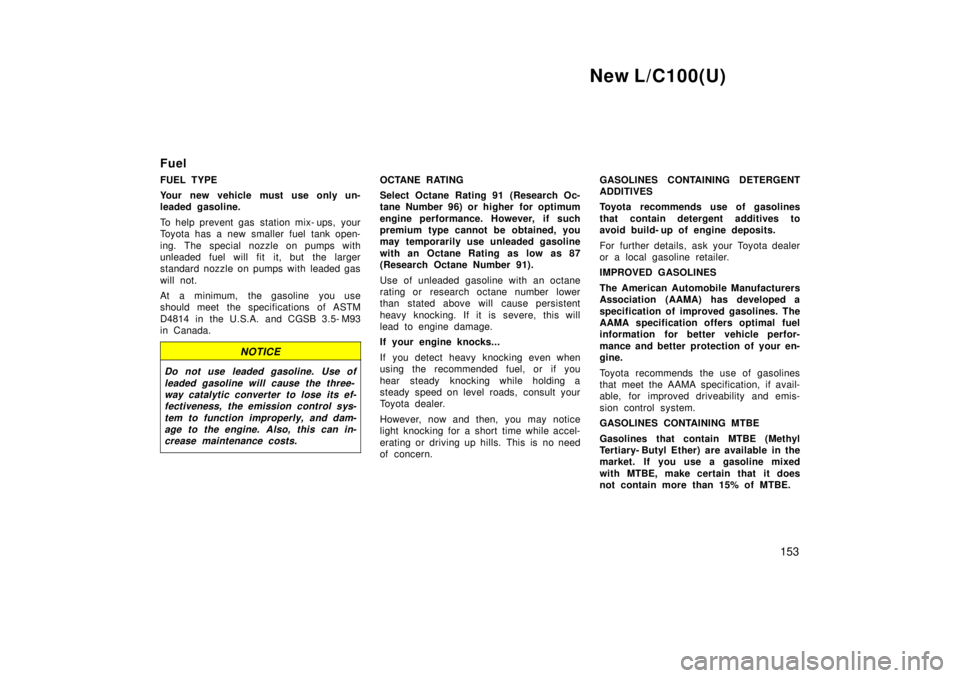
New L/C100(U)153
Fuel
FUEL TYPE
Your new vehicle must use only un-
leaded gasoline.
To help prevent gas station mix- ups, your
Toyota has a new smaller fuel tank open-
ing. The special nozzle on pumps with
unleaded fuel will fit it, but the larger
standard nozzle on pumps with leaded gas
will not.
At a minimum, the gasoline you use
should meet the specifications of ASTM
D4814 in the U.S.A. and CGSB 3.5- M93
in Canada.
NOTICE
Do not use leaded gasoline. Use of
leaded gasoline will cause the three-way catalytic converter to lose its ef-
fectiveness, the emission control sys-
tem to function improperly, and dam-age to the engine. Also, this can in-crease maintenance costs.
OCTANE RATING
Select Octane Rating 91 (Research Oc-
tane Number 96) or higher for optimum
engine performance. However, if such
premium type cannot be obtained, you
may temporarily use unleaded gasoline
with an Octane Rating as low as 87
(Research Octane Number 91).
Use of unleaded gasoline with an octane
rating or research octane number lower
than stated above will cause persistent
heavy knocking. If it is severe, this will
lead to engine damage.
If your engine knocks...
If you detect heavy knocking even when
using the recommended fuel, or if you
hear steady knocking while holding a
steady speed on level roads, consult your
Toyota dealer.
However, now and then, you may notice
light knocking for a short time while accel-
erating or driving up hills. This is no need
of concern. GASOLINES CONTAINING DETERGENT
ADDITIVES
Toyota recommends use of gasolines
that contain detergent additives to
avoid build- up of engine deposits.
For further details, ask your Toyota dealer
or a local gasoline retailer.
IMPROVED GASOLINES
The American Automobile Manufacturers
Association (AAMA) has developed a
specification of improved gasolines. The
AAMA specification offers optimal fuel
information for better vehicle perfor-
mance and better protection of your en-
gine.
Toyota recommends the use of gasolines
that meet the AAMA specification, if avail-
able, for improved driveability and emis-
sion control system.
GASOLINES CONTAINING MTBE
Gasolines that contain MTBE (Methyl
Tertiary- Butyl Ether) are available in the
market. If you use a gasoline mixed
with MTBE, make certain that it does
not contain more than 15% of MTBE.
Page 175 of 202
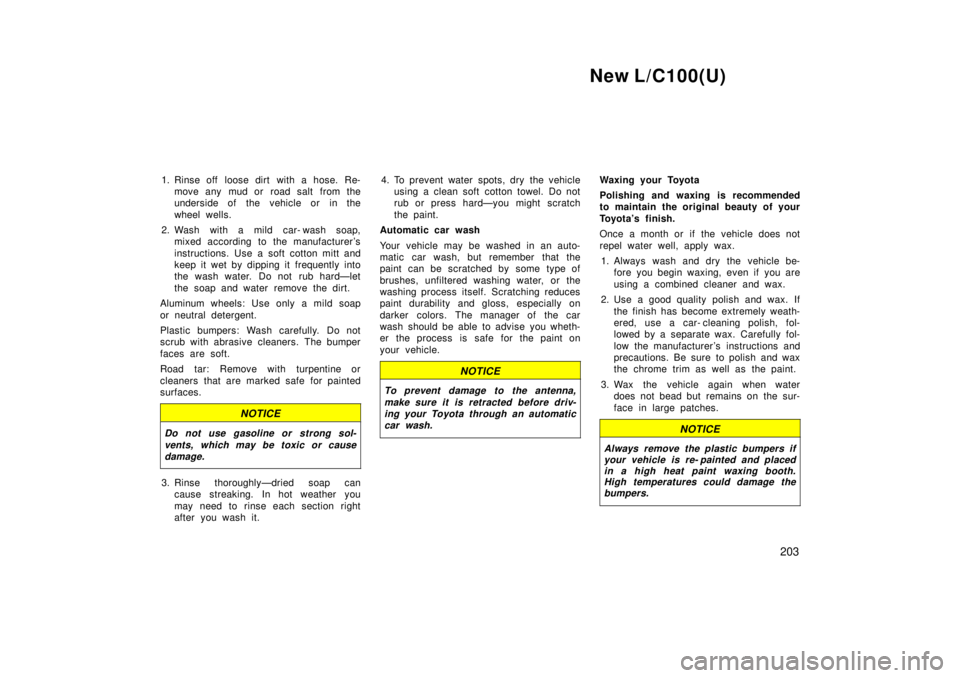
New L/C100(U)203
1. Rinse off loose dirt with a hose. Re-
move any mud or road salt from the
underside of the vehicle or in the
wheel wells.
2. Wash with a mild car- wash soap, mixed according to the manufacturer 's
instructions. Use a soft cotton mitt and
keep it wet by dipping it frequently into
the wash water. Do not rub hardÐlet
the soap and water remove the dirt.
Aluminum wheels: Use only a mild soap
or neutral detergent.
Plastic bumpers: Wash carefully. Do not
scrub with abrasive cleaners. The bumper
faces are soft.
Road tar: Remove with turpentine or
cleaners that are marked safe for painted
surfaces.
NOTICE
Do not use gasoline or strong sol- vents, which may be toxic or causedamage.
3. Rinse thoroughlyÐdried soap can cause streaking. In hot weather you
may need to rinse each section right
after you wash it. 4. To prevent water spots, dry the vehicle
using a clean soft cotton towel. Do not
rub or press hardÐyou might scratch
the paint.
Automatic car wash
Your vehicle may be washed in an auto-
matic car wash, but remember that the
paint can be scratched by some type of
brushes, unfiltered washing water, or the
washing process itself. Scratching reduces
paint durability and gloss, especially on
darker colors. The manager of the car
wash should be able to advise you wheth-
er the process is safe for the paint on
your vehicle.
NOTICE
To prevent damage to the antenna, make sure it is retracted before driv-ing your Toyota through an automatic
car wash.
Waxing your Toyota
Polishing and waxing is recommended
to maintain the original beauty of your
Toyota's finish.
Once a month or if the vehicle does not
repel water well, apply wax.
1. Always wash and dry the vehicle be- fore you begin waxing, even if you are
using a combined cleaner and wax.
2. Use a good quality polish and wax. If the finish has become extremely weath-
ered, use a car- cleaning polish, fol-
lowed by a separate wax. Carefully fol-
low the manufacturer 's instructions and
precautions. Be sure to polish and wax
the chrome trim as well as the paint.
3. Wax the vehicle again when water does not bead but remains on the sur-
face in large patches.
NOTICE
Always remove the plastic bumpers ifyour vehicle is re- painted and placedin a high heat paint waxing booth.High temperatures could damage the
bumpers.
Page 176 of 202
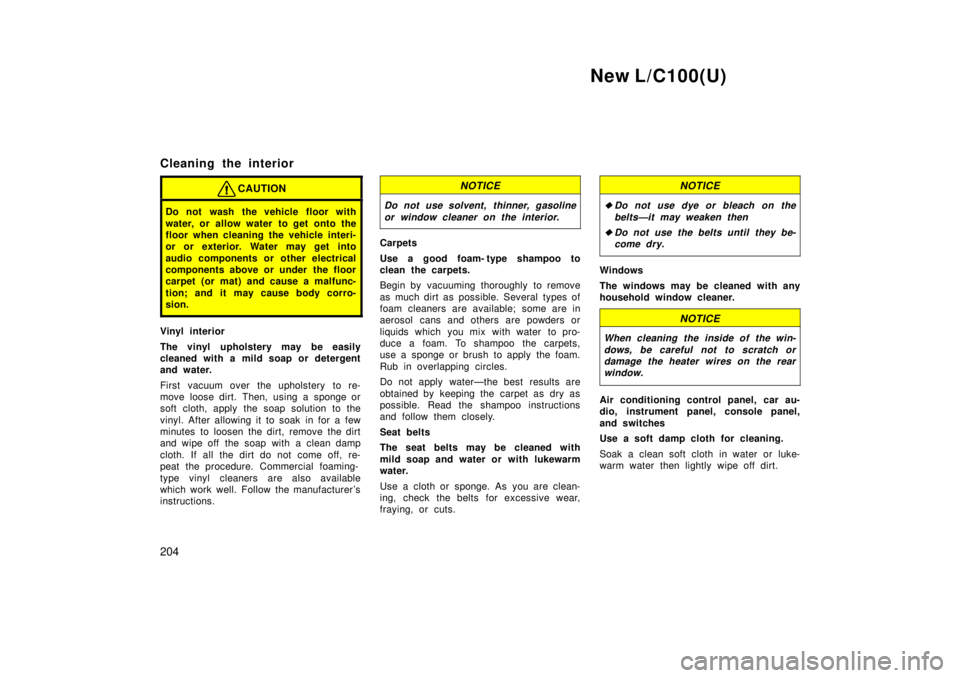
New L/C100(U)
204
Cleaning the interior
CAUTION
Do not wash the vehicle floor with
water, or allow water to get onto the
floor when cleaning the vehicle interi-
or or exterior. Water may get into
audio components or other electrical
components above or under the floor
carpet (or mat) and cause a malfunc-
tion; and it may cause body corro-
sion.
Vinyl interior
The vinyl upholstery may be easily
cleaned with a mild soap or detergent
and water.
First vacuum over the upholstery to re-
move loose dirt. Then, using a sponge or
soft cloth, apply the soap solution to the
vinyl. After allowing it to soak in for a few
minutes to loosen the dirt, remove the dirt
and wipe off the soap with a clean damp
cloth. If all the dirt do not come off, re-
peat the procedure. Commercial foaming-
type vinyl cleaners are also available
which work well. Follow the manufacturer 's
instructions.
NOTICE
Do not use solvent, thinner, gasoline
or window cleaner on the interior.
Carpets
Use a good foam- type shampoo to
clean the carpets.
Begin by vacuuming thoroughly to remove
as much dirt as possible. Several types of
foam cleaners are available; some are in
aerosol cans and others are powders or
liquids which you mix with water to pro-
duce a foam. To shampoo the carpets,
use a sponge or brush to apply the foam.
Rub in overlapping circles.
Do not apply waterÐthe best results are
obtained by keeping the carpet as dry as
possible. Read the shampoo instructions
and follow them closely.
Seat belts
The seat belts may be cleaned with
mild soap and water or with lukewarm
water.
Use a cloth or sponge. As you are clean-
ing, check the belts for excessive wear,
fraying, or cuts.
NOTICE
�Do not use dye or bleach on thebeltsÐit may weaken then
�Do not use the belts until they be-come dry.
Windows
The windows may be cleaned with any
household window cleaner.
NOTICE
When cleaning the inside of the win-
dows, be careful not to scratch ordamage the heater wires on the rear window.
Air conditioning control panel, car au-
dio, instrument panel, console panel,
and switches
Use a soft damp cloth for cleaning.
Soak a clean soft cloth in water or luke-
warm water then lightly wipe off dirt.
Page 191 of 202
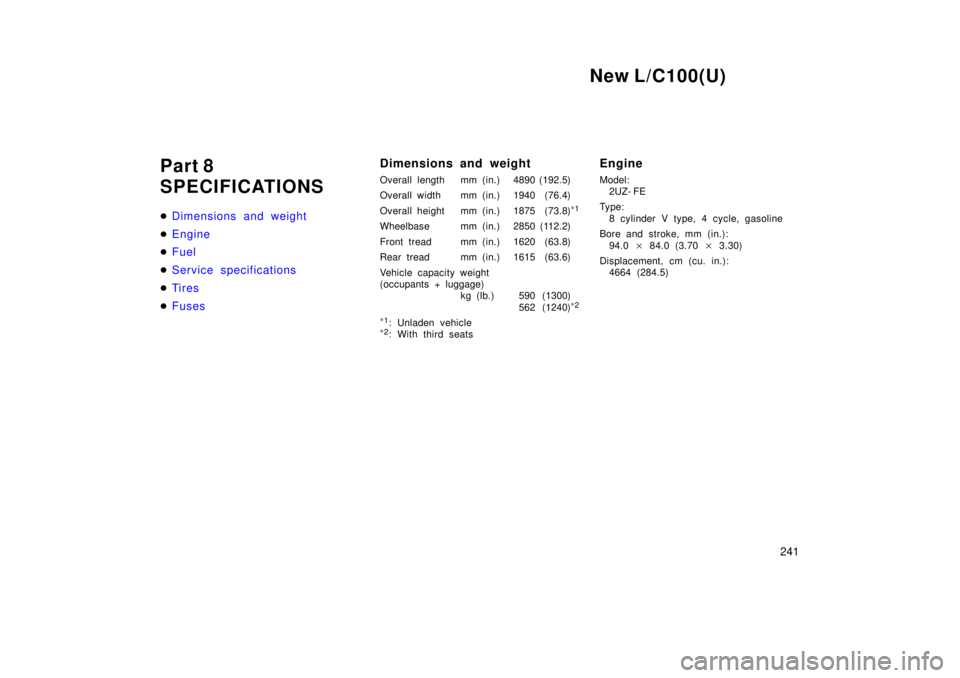
New L/C100(U)241
Part 8
SPECIFICATIONS �
Dimensions and weight
�Engine
�Fuel
�Service specifications
�Ti r es
�Fuses
Dimensions and weight
Overall length mm (in.) 4890 (192.5)
Overall width mm (in.) 1940 (76.4)
Overall height mm (in.) 1875 (73.8)
*
1
Wheelbase mm (in.) 2850 (112.2)
Front tread mm (in.) 1620 (63.8)
Rear tread mm (in.) 1615 (63.6)
Vehicle capacity weight
(occupants + luggage) kg (lb.) 590 (1300)
562 (1240)*
2
* 1
: Unladen vehicle
* 2
: With third seats Engine
Model:
2UZ- FE
Type: 8 cylinder V type, 4 cycle, gasoline
Bore and stroke, mm (in.): 94.0 � 84.0 (3.70 � 3.30)
Displacement, cm (cu. in.): 4664 (284.5)
Page 192 of 202
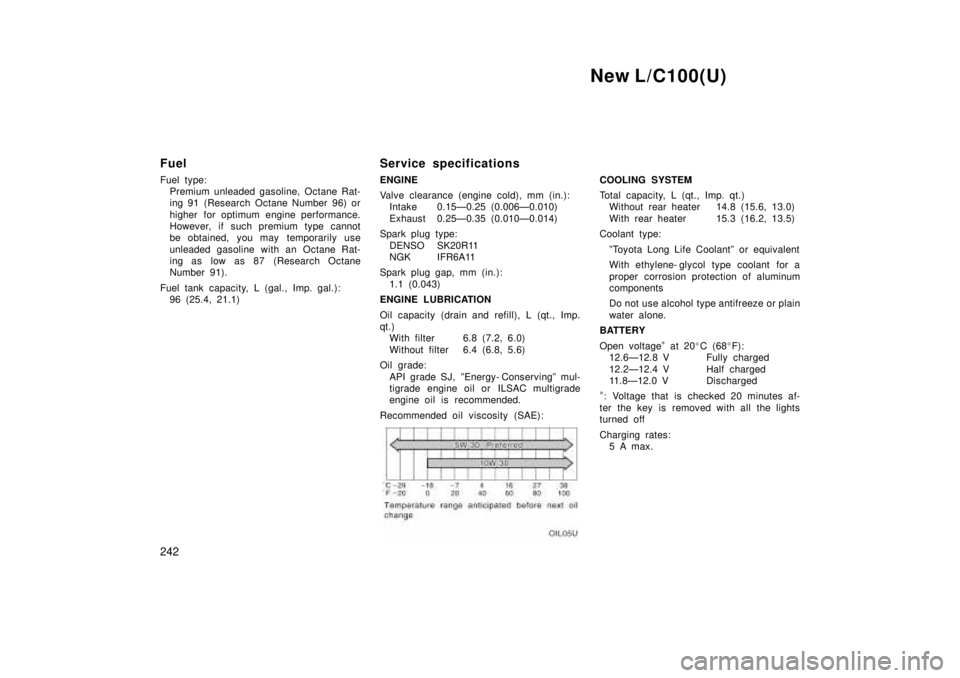
New L/C100(U)
242
Fuel
Fuel type:
Premium unleaded gasoline, Octane Rat-
ing 91 (Research Octane Number 96) or
higher for optimum engine performance.
However, if such premium type cannot
be obtained, you may temporarily use
unleaded gasoline with an Octane Rat-
ing as low as 87 (Research Octane
Number 91).
Fuel tank capacity, L (gal., Imp. gal.): 96 (25.4, 21.1) Service specifications
ENGINE
Valve clearance (engine cold), mm (in.):
Intake 0.15Ð0.25 (0.006Ð0.010)
Exhaust 0.25Ð0.35 (0.010Ð0.014)
Spark plug type: DENSO SK20R11
NGK IFR6A11
Spark plug gap, mm (in.): 1.1 (0.043)
ENGINE LUBRICATION
Oil capacity (drain and ref ill), L (qt., Imp.
qt.)
With filter 6.8 (7.2, 6.0)
Without filter 6.4 (6.8, 5.6)
Oil grade: API grade SJ, ºEnergy- Conservingº mul-
tigrade engine oil or ILSAC multigrade
engine oil is recommended.
Recommended oil viscosity (SAE):
COOLING SYSTEM
Total capacity, L (qt., Imp. qt.) Without rear heater 14.8 (15.6, 13.0)
With rear heater 15.3 (16.2, 13.5)
Coolant type:
ºToyota Long Life Coolantº or equivalent
With ethylene- glycol type coolant for a
proper corrosion protection of aluminum
components
Do not use alcohol type antifreeze or plain
water alone.
BATTERY
Open voltage *
at 20 �C (68 �F):
12.6Ð12.8 V Fully charged
12.2Ð12.4 V Half charged
11.8Ð12.0 V Discharged
* : Voltage that is checked 20 minutes af-
ter the key is removed with all the lights
turned off
Charging rates: 5 A max.
Page 202 of 202

New L/C100(U)Publication No. OM60811U
Part No. 01999-60811
Printed in Japan 01- 9810- 00
(U)
Quick index
� If a service reminder indicator or warning buzzer comes on 94 . . . . .
� If your vehicle will not start 181
. . . . . . . . . . . . . . . . . . . . . . . . . . . . . . . . . . .
� If your engine stalls while driving 185 . . . . . . . . . . . . . . . . . . . . . . . . . . . . . .
� If your vehicle overheats 185
. . . . . . . . . . . . . . . . . . . . . . . . . . . . . . . . . . . . . .
� If you have a flat tire 186
. . . . . . . . . . . . . . . . . . . . . . . . . . . . . . . . . . . . . . . . .
� If your vehicle needs to be towed 195 . . . . . . . . . . . . . . . . . . . . . . . . . . . . .
� Tips for driving during break-in period 152 . . . . . . . . . . . . . . . . . . . . . . . . . .
� How to start the engine 167
. . . . . . . . . . . . . . . . . . . . . . . . . . . . . . . . . . . . . . .
� General maintenance 208
. . . . . . . . . . . . . . . . . . . . . . . . . . . . . . . . . . . . . . . . . .
� Complete index NO TAG
. . . . . . . . . . . . . . . . . . . . . . . . . . . . . . . . . . . . . . . . . .
Gas station information
Fuel type: Premium UNLEADED gasoline, Octane Rating 91 (Research Octane
Number 96) or higher for optimum engine performance However, if
such premium type cannot be obtained, you may temporarily use
unleaded gasoline with an Octane Rating as low as 87 (Research
Octane Number 91).
See page 153 for detailed information.
Fuel tank capacity: 96 L (25.4 gal., 21.1 lmp. gal.)
Engine oil:
API grade SJ, ºEnergy- Conservingº multigrade engine oil or ILSAC
multigrade engine oil is recommended.
See page 220 for detailed information.
Automatic transmission fluid: Automatic transmission fluid D- II or DEXRON �
III (DEXRON �
II)
Tire information: See pages 224 through 228.
Tire pressure: See page 244.
U�3
I